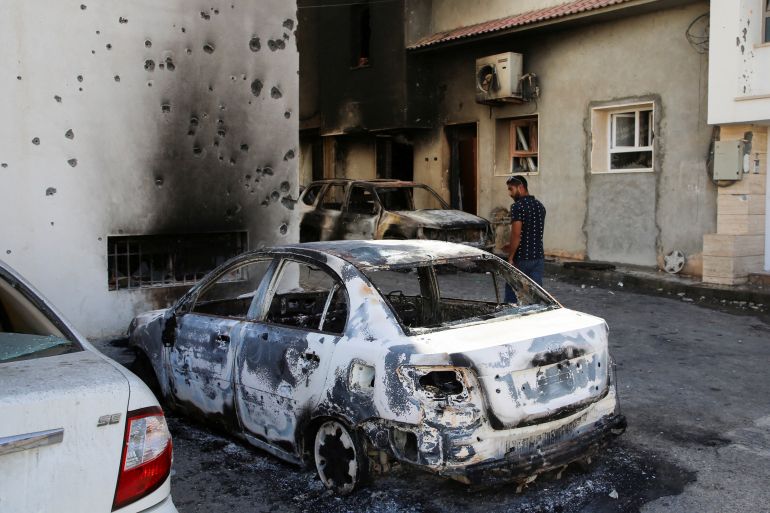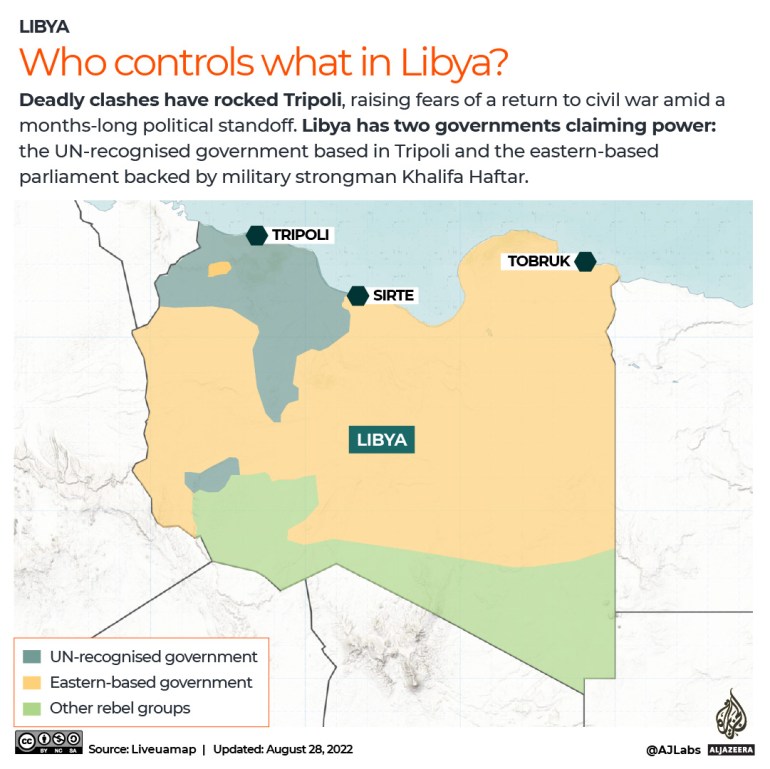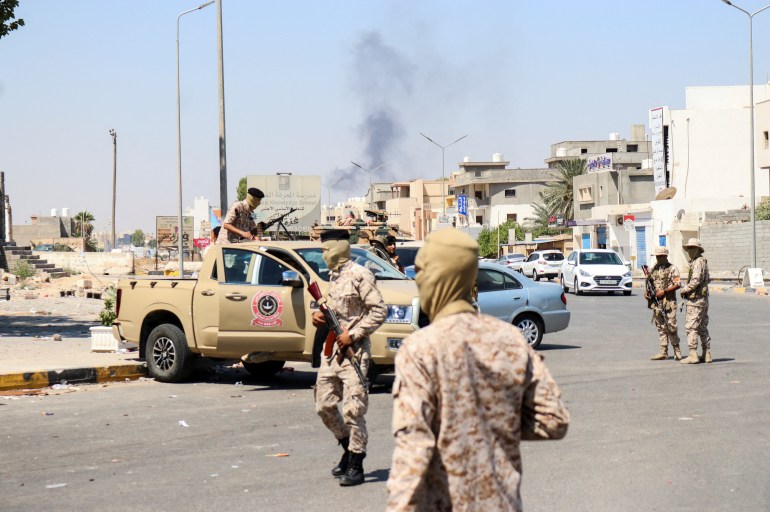What we know about Libya’s worst fighting in two years
At least 32 people killed and 159 more wounded in the clashes amid fears of escalating violence in the country divided between rival governments.

Deadly clashes broke out between rival Libyan militias in the centre of Tripoli late on Friday and into the early hours of Saturday, raising fears of escalating violence in the country divided between rival administrations jostling to wrest control of the oil-rich North African nation.
The health ministry said on Sunday that 32 people were killed in Saturday’s violence and 159 were injured, up from a ministry source’s previous estimate of 23 deaths and 87 injured.
Keep reading
list of 3 itemsDeadly clashes between rival armed groups erupt in Libyan capital
What’s the biggest threat to Libya?
Armed fighters backing the United Nations-recognised government based in Tripoli and the forces loyal to rival Prime Minister Fathi Bashagha have been engaged in the gun fighting threatening the civilian population, with health officials urging for a truce to evacuate people and to provide safe passage to aid the injured.
Tensions have simmered since Bashagha was appointed prime minister in February by the eastern parliament based in Tobruk, with Prime Minister Abdul Hamid Dbeibah, the head of the UN-recognised Government of National Unity (GNU), refusing to cede power.
The UN-backed government says it has taken control of the capital after the worst fighting in two years.
Here is what we know so far.

What were the casualties?
- At least 32 people were killed and 150 more were wounded in the clashes, according to the country’s health ministry.
- Among those killed was Mustafa Baraka, a comedian known for his social media videos mocking militias and corruption. Baraka died after he was shot in his chest, said Malek Merset, an emergency services spokesman.
- Merset said emergency services were still trying to evacuate wounded people and civilians trapped in the fighting.
- The health ministry said 140 people had been wounded while 64 families had to be evacuated from areas around the fighting. It said hospitals and medical centres in the capital were shelled, and ambulance teams were barred from evacuating civilians, in acts that “amount to war crimes”.
Who are the fighting parties?
- Two rival militias were involved in the violence, one affiliated with Dbeibah and the other backing the rival government of Bashagha, whose administration has the backing of eastern-based renegade military commander Khalifa Haftar.
- Bashagha’s attempt on Saturday to take over in Tripoli was his second such attempt since May.
- Witnesses told the Reuters news agency that forces aligned with Bashagha tried to take territory in Tripoli from several directions on Saturday, but his main military convoy turned back towards the coastal city of Misrata before reaching the capital.
- Sources told Al Jazeera that the militia backing Dbeibah tried to take over the headquarters of Haitham al-Tajouri forces, which back Bashagha, leading to the exchange of heavy weaponry.

What’s behind the violence?
- Tensions have risen after Bashagha’s appointment as prime minister in February amid calls for Dbeibah to cede power.
- Dbeibah’s GNU, installed as part of a UN-led peace process following a previous round of violence, said the latest clashes in Tripoli were triggered by fighters aligned with Bashagha firing on a convoy in the capital while other pro-Bashagha units had massed outside the city.
- It accused Bashagha of backing out of talks to resolve the crisis. Bashagha says the GNU’s mandate has expired. But he has so far been unable to take office in Tripoli, as Dbeibah has insisted he will hand over power only to an elected government.
- A statement from forces supporting Dbeibah said it carried out an operation to push back a security threat in Tripoli caused by Haitham al-Tajouri’s forces. The statement said the operation aimed to defend the city and its residents and avoid a long period of tensions and clashes.

What has the reaction been?
- Turkey, which has a military presence around Tripoli and helped forces in the city fight off an eastern assault in 2020, called for an immediate ceasefire and said “we continue to stand by our Libyan brothers”.
- The United States ambassador to Libya, Richard Norland, said in a statement that Washington “condemns” the surge in violence, urging an “immediate ceasefire and UN-facilitated talks between the conflicting parties”.
- The municipal council of Tripoli blamed the ruling political class for the deteriorating situation in the capital, and urged the international community to “protect civilians in Libya”.
- Omar Weheba, a city official, said civil society institutions in Tripoli strongly condemned the armed clashes and held “the participating parties responsible for shedding civilian blood, intimidating security, and destroying private and public property”.
Are there fears of escalation?
- Emadeddin Badi, a senior fellow at the Atlantic Council, warned that the violence could quickly escalate. “Urban warfare has its own logic, it’s harmful both to civilian infrastructure and to people, so even if it isn’t a long war, this conflict will be very destructive as we have already seen,” he told the AFP news agency.
- He added that the fighting could strengthen Haftar and those close to him. “They stand to benefit from western Libya divisions and have a better negotiating position once the dust settles.”